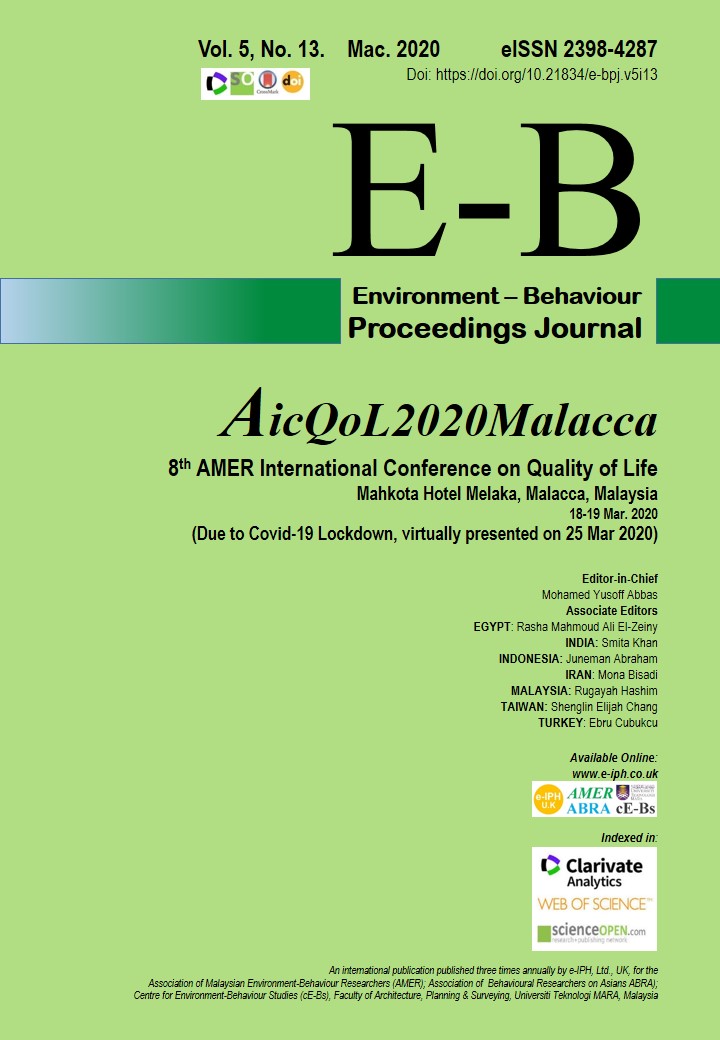Analyzing Spaces for Social Interaction in Coworking Space: A case study on Common Ground Damansara Heights
DOI:
https://doi.org/10.21834/e-bpj.v5i13.2068Keywords:
Coworking, Social InteractionAbstract

Coworking is defined as people work and share the same facilities; creating social interaction to form a community. Through literature publication in Asia, most of the studies are focusing on market value and revenue; lack study on social interaction topic. This study aims to analyse spaces for user social interaction in coworking space in Common Ground Damansara Heights. To achieve the aim, it identifies types of social interaction in coworking space. Site observation and data are analysed to determine the availability of spaces for social interaction. This conclusion informs suggestion to designers and academics on consideration in coworking spaces for user to socialise.
Keywords: Coworking; social interaction
eISSN: 2398-4287 © 2020. The Authors. Published for AMER ABRA cE-Bs by e-International Publishing House, Ltd., UK. This is an open access article under the CC BYNC-ND license (http://creativecommons.org/licenses/by-nc-nd/4.0/). Peer–review under responsibility of AMER (Association of Malaysian Environment-Behaviour Researchers), ABRA (Association of Behavioural Researchers on Asians) and cE-Bs (Centre for Environment-Behaviour Studies), Faculty of Architecture, Planning & Surveying, Universiti Teknologi MARA, Malaysia.
DOI: https://doi.org/10.21834/e-bpj.v5i13.2068
References
Aliff Yusri. (2018). Room to Grow: Co-Working Spaces and SMEs.
Bilandzic, M., & Foth, M. (2015). Designing hubs for connected learning: Social, spatial and technological insights from coworking, hackerpaces and meetup Groups.
Botsman, R., & Rogers, R. (2011). What’s Mine Is Yours: How Collaborative Consumption Is Changing the Way We Live. 2nd edition. Londres: Harper Collins.
Cabral, V. & Willem, V. W. (2016). Coworking: An analysis of coworking strategies for interaction and innovation. doi: 10.13140/RG.2.1.4404.5208
Capdevila, I. (2015). Co-working spaces and the localised dynamics of innova-tion in Barcelona. International Journal of Innovation Management, 19(3). https://doi.org/10.1142/S1363919615400046
Common Ground. (2019). Retrieved from https://www.commonground.work/
Coworking.org (2019). Retrieved from http://coworking.com/
Dhand, N. (2019). Descriptive Analysis: Take it easy. Retrieved from http://statulator.com/blog/descriptive-analysis-take-it-easy/
Fost, D. (2008) ‘They’re working on their own, just side by side’. New York Times, 20 February.
Frank, K. (2018). Cotra-working: The office of the future?
Gandini, A. (2015). The rise of coworking spaces: A literature review. volume 15(1): 193-205. ISSN 1473-2866
Goffman, E. (1955). On facework: an analysis of ritual elements in social interaction. Psychiatry: Journal for the Study of Interpersonal Processes 18: 213-231.
Hillman, A. (2008). 6 reasons to start coworking. Retrieved from http://mashable.com/2008/11/07/reasons-to-start-coworking/#0RcXbSvNdEqQ.
Hillman, A. (2014). To build a strong community, stop “community managingâ€, be a Tummler instead.
Hua, Y., Loftness, V., Kraut, R., & Powell, K. M. (2010). Workplace collaborative space layout typology and occupant perception of collaboration environment. Environment and Planning B: Planning and Design, 37, 429-448.
Hunt, T. (2009). The whuffie factor: Using the power of social networks to build your business. Crown Pub ILO/Hart Publishing.
Ivaldi, S., Pais, I., & Scaratti, G. (2018). Coworking(s) in the Plural: Coworking Spaces and New Ways of Managing. DOI: 10.1007/978-3-319-66038-7_11
Johns, T., & Gratton, L. (2013). The third wave of virtual work: Knowledge workers are now untethered, able to perform tasks anywhere at any time. What do the best of them want from your organization. Harvard Business Review, January–February, 1–9.
Kim, J., & de Dear, R. (2013). Workspace satisfaction: The privacy-communication trade-off in open-plan offices. Journal of Environmental Psychology. doi:10.1016/j.jenvp.2013.06.007
Kojo, I., & Nenonen, S. (2017). Evolution of co-working places: drivers and possibilities. Intelligent buildings international, 9(3), 164-175.
Liegl, M. (2014). Nomadicity and the care of place—on the aesthetic and affective organization of space in freelance creative work. Computer Supported Cooperative Work (CSCW), 23(2), 163-183.
Lim, J.Y. (2018). Curating Coworking Space as A Third Place. https://issuu.com/joanna.lim.yin/docs/curating_coworking_space_as_a_third
Lumley, R. M. (2014). A coworking project in the campus library: supporting and modeling entrepreneurial activity in the academic library. New Review of Academic Librarianship, 20(1), 49-65.
Moriset, B. (2013). Building new places of the creative economy. The rise of coworking spaces.
Ondia, E. P., Hengrasmee, S., & Chansomsak, S. (2018). Spatial Configuration and Users’ Behavior in Co-working Spaces. Ybl Journal of Built Environment, 6(1), doi:10.2478/jbe-2018-0002
Parrino, L. (2015). Coworking: Assessing the role of proximity knowledge exchange. Knowledge Management Research and Practice, 13, 261–271.
Perree, M. W., Koevering, J., Meulenbroek, R. A., & Arentze, T. (2019). Analysing user preferences for co-working space characteristics. Building Research & Information, 47(5), 534-548, doi: 10.1080/09613218.2018.1463750
Shinn, M. , Lehmann, S., & Wong, N. W. (1984). Social interaction and social support. J. Soc.Issues 40, 55–76. doi:10.1111/j.1540-4560.1984.tb01107.x
Spinuzzi, C. (2012). Working alone together coworking as emergent collaborative activity. Journal of Business and Technical Communication,26(4), 399-441.
Spreitzer, G. et.al. (2015). Why People Thrive in Coworking Spaces. Retrieved from https://hbr.org/2015/05/why-people-thrive-in-coworking-spaces
Sundsted, T., Jones, D., & Bacigalupo, T. (2009). I'm outta here: How coworking is making the office obsolete.
Tie, E. (2018). Coworking Spaces. Retrieved from www.etcsea.com
Downloads
Published
How to Cite
Issue
Section
License
Copyright (c) 2020 Ken Ying Cho, Filzani Illia Ibrahim, Zahari Zubir

This work is licensed under a Creative Commons Attribution-NonCommercial-NoDerivatives 4.0 International License.





